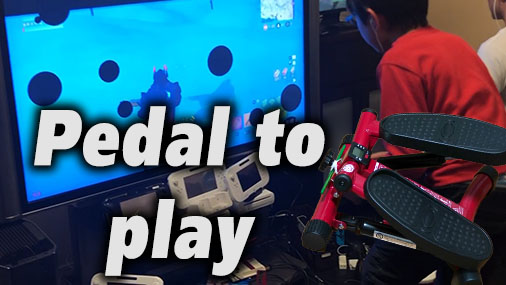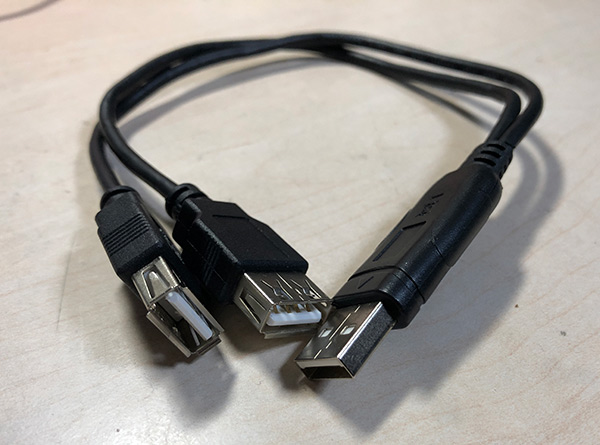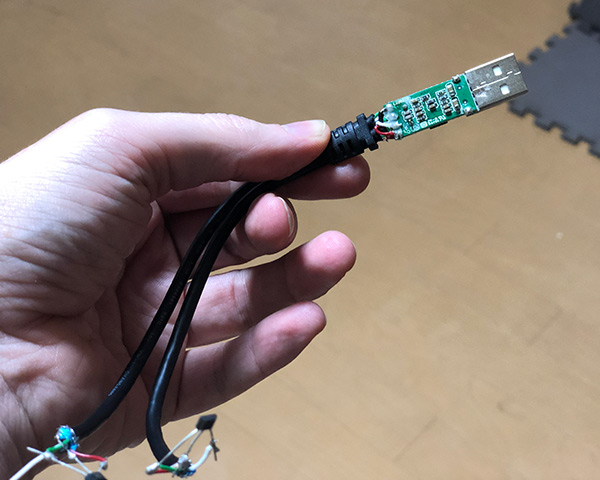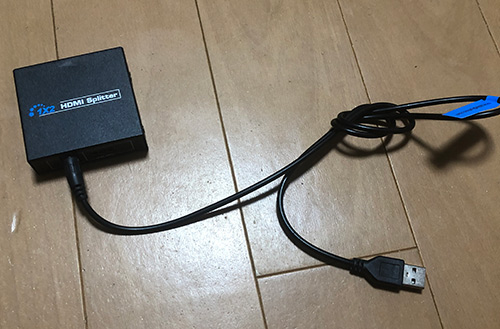Sure, there are ways to get exercise while gaming. Virtual reality and music games like Dance Dance Revolution come to mind.
But that’s all worthless when your kid just wants to play Fortnite.
Behold, the PlayStep!
Edit: Also check out the PlayStep Mini, a $10 version!
This thing forces him to work up a sweat. This post details what methods I used and issues I had making it. (Github source code for the program that runs on the Pi here for anybody who wants to make one)
Building a screen blanker connected to exercise isn’t a new idea (see the end of this post for related links I found) but my version does have some novel features:
- Dynamically modifies the video and audio of the game’s HDMI signal to do things like partially obscure the screen in random ways
- Uses an energy bank so you can save up game time. This means you can madly pedal in the lobby and still sit in a chair during the critical parts of Fortnite
I first built a cheap version (~$120 in parts). It just blanks the screen when you’re out of energy, and uses an LCD screen to show energy left.
I then did a better but more expensive way (~$700 in parts) but it’s a lot cooler.
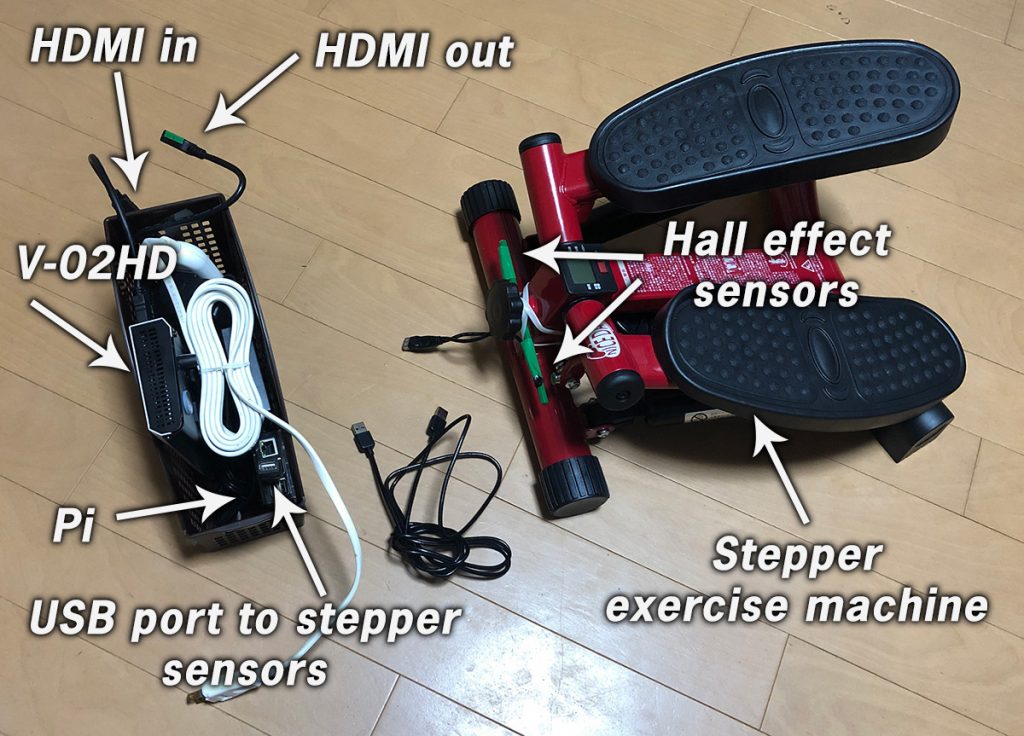
The expensive version with HDMI in/out, the “enclosure” is a plastic basket thing from the dollar store
Things both ways have in common:
- Use a Raspberry Pi 3B+ (a $40 computer with hardware GLES acceleration) with the Retropie distro – I start with it because its mouse/keyboard/GLES/SDL works out of the box with Proton SDK where normal Raspian requires tweaking/compiling some things
- Use Proton SDK for for the app base (allows me to design/test on Windows, handles abstraction for many platforms so I can write once but run everywhere)
- Use hall effect sensors to detect the pedal down position on each pedal via the Pi’s GPIO, this way a kid can’t cheat, he’s forced to move the full range of the stepper
- The sensors are placed on a stepper exerciser. I used a USB connector for the wiring so I could unplug/replace it later if I wanted to setup a different exercise machine, like if I ever got a stationary bike.
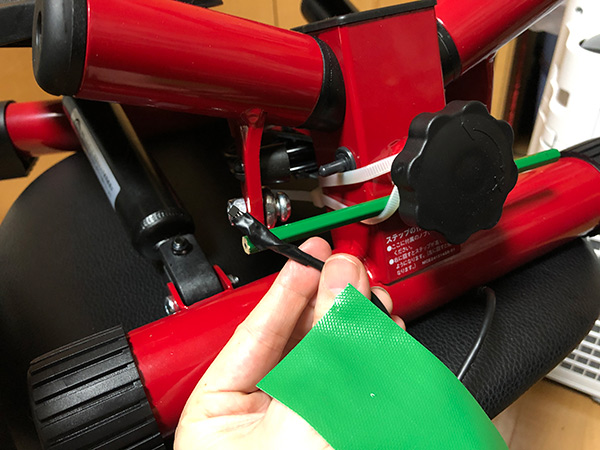
Yes, I’m about to duct tape an electrical taped sensor to a pencil that has been zip-tied in place. What? I never said I was pro
A note on using USB cables for wires and my idiocy
Each hall effect sensor requires three wires. We have two sensors. So we need to run six wires from the Pi GPIO pins? WRONG! We only need four because the power and ground can be shared between them.
Update: This was dumb, I later just used the built in hall effect sensor these steppers already have. You just need one, it doesn’t force the same range but it’s good enough.
So I thought hey, I’ll use USB cables and connectors laying around as they have four wires in them. (until we get to USB 3+ cables, but ignore that)
Then I thought, if I could find a simple USB Y splitter, it will be easier to share the power/ground with the two sensors . (I’m not actually using this as a USB connection, it’s just so I can use the wire and handy plugs)
Wow, I found this for cheap on Amazon:
So I partially wired it up but when testing found that the middle pins had no continuity. Can you guess why?
It’s got a hub or something hidden in the connector. I never plugged it into an actual PC or I might have noticed. No wonder it didn’t work. I removed the electronics part (it was a horror, I shouldn’t be allowed near soldering irons) and it worked as expected. Moral of the story is, I’m dumb, and don’t trust USB splitters to just split the wires.
The cheap way (just screen blanking with LCD panel)
My “cheap” way ignores rendering anything graphical (It doesn’t output any HDMI itself) and just shows a single “energy count” number on an LCD screen. When it gets low, the game’s HDMI signal will be completely shut off until it goes positive again. In the video above I’m using little buttons to test with instead of the stepper.
Edit: Check out this all-in-one more svelte version I did more recently
To help the user notice the screen is about to shut off it makes a beeping noise as the counter nears zero.
I suggest never testing this at an airport, can’t stress that enough really.
So how can a Raspberry Pi turn on/off the game’s HDMI signal?
This is hacky but it works – I took an old 1X2 HDMI splitter and powered it from one of the Pi’s USB ports. (lots of electronics these days use a USB plug for power)
I only use one of the outputs on the splitter as I don’t really need any splitting done.
It’s possible to kill the power on a specific Pi USB port using a utility called uhubctrl.
So when the player is out of “energy”, I kill the USB port powering the HDMI splitter by having my C++ code run a system command of:
./uhubctl -a off -p 2
And because the HDMI splitter is now unpowered, the signal dies killing the game screen.
After turning the USB port back on (replacing “off” with “on”) it will power up and start processing the HDMI signal again. Originally I was using the Pi to turn on/off an entire AC outlet but that seemed like overkill – I was thinking maybe turning off an entire TV or something, but meh.
So the big downsize of this method is it takes up to 5 seconds for the HDMI splitter to turn back on, and your TV to recognize the signal again. It works but… not optimal. Also, in my case I don’t really have a good place to put the LCD screen or speaker for the beeping. (might make more sense on a stationary bike instead of a stepper)
Alternate way to disable the HDMI signal : Instead of this no-wiring hack, maybe instead run it through an HDMI cable but put one of the pins into a relay to turn that pin on/off? Might be the same effect but cheaper and simpler.. although, which pin?!
The expensive but better way (offers more options with images and audio)
There isn’t enough drama in simply turning the HDMI signal on/off – wouldn’t it be better if holes started spawning randomly over your actual gameplay and you had to pedal to remove them as your screen became increasingly obscured?! There are a million options, really.
The Raspberry Pi can generate the graphics (thanks GLES) and audio but we need a way to overlay its HDMI output over the game’s HDMI signal with no noticeable latency costs at 60fp.
This is known as a chroma key effect. (Side note: I once bought a $5,000 video mixer in the 90s so I could do live-effects like this, a WJ-MX 50. Just saw one on ebay for $100, damn it’s big)
The cheapest stand-alone way I found to do it these days is a Roland V-02HD video switcher. (I bought it for $664 USD from Amazon Japan)
Does anybody know a better/cheaper alternative? If I could figure out a no latency way to overlay with an alpha channel instead of just chroma that would really be ideal.
Edit: The Atem Mini HDMI Live switcher looks like it would work too, it’s a bit cheaper.
Further edit: Check out the $10 version I built, although it lacks the bells and whistles
It’s pricey, but it works perfectly. It has the following features of interest:
- Remembers all settings when powered on, including chroma key mode and color/sensitivity
- Can disable auto-detection so inputs 1 and 2 are always the same even if input is turned off
- Can disable all buttons/levers on it so accidental changes won’t happen (we don’t need them active, it’s just a black box to us)
- It’s pretty small for a video switcher
- Mixes audio into the HDMI signal from both inputs
- No noticeable latency
Although I didn’t need or use it, it’s worth noting that it can show up as a USB MIDI device and be controlled via MIDI signals. I did not need those features but that’s pretty cool, assuming the Pi could work with it, you could do transitions between inputs or enable/disable effects.
The Software
The software to control things uses Proton SDK with its SDL2 backend and WiringPi for the GPIO to read from the sensors. It’s modified from the RTBareBones example.
It uses a config.txt file to adjust a couple things:
max_energy|600 energy_timer|1000 energy_per_move|7
PlayStep Source code on github
Here’s some info on how to compile Proton examples.
To allow the Pi to correctly output 1080P HDMI even if the switcher hasn’t booted up yet, I edited the /boot/config.txt and set:
hdmi_force_hotplug=1 hdmi_drive=2
To fix remove the unnecessary border I also set:
disable_overscan=1
Final thoughts
Might be fun to simply design Pi powered pedal games that use the stepper as a controller. You could then output straight to a TV or TFT screen without worrying about the spendy chroma-keying solution.
I mean, sure, my kid would refuse to play it, but it could be a funny thing to show at a meet-up or something.
Related things to check out
- Cycflix: Exercise Powered Entertainment – Uses a laptop to pause netflix if you don’t pedal fast enough. He connected an arduino directly to the existing stationary bike electronics to measure pedaling, smart.
- No TV unless you exercise! – Arduino mounted on a stationary bike cuts RCA signal via a relay if you don’t pedal enough. Uses a black/white detector for movement rather than hall effect sensors.
- TV Pedaler – A commercial product that blanks screen if you don’t pedal enough that is still being sold? The website and product seem really old (no HDMI support) but they accept Paypal and the creator posted here a few years ago about his 1999 patent and warned about “copying”. Hrmph. His patent covers a bunch of random ideas that his machine doesn’t use at all. Patents like this are dumb, good thing it says “Application status is Expired – Fee Related” I guess.
- The EnterTRAINER – This defunct commercial device is basically a TV remote control with a heart monitor you strap to your chest. Controls volume and TV power if your heart rate goes too low. Its hilarious infomercial was posted in one of the reviews.
- The 123GoTV KidExerciser – Ancient commercial product that lets you use your own bike in the house to blank the TV if not pedalled fast enough. Company seems gone now.

